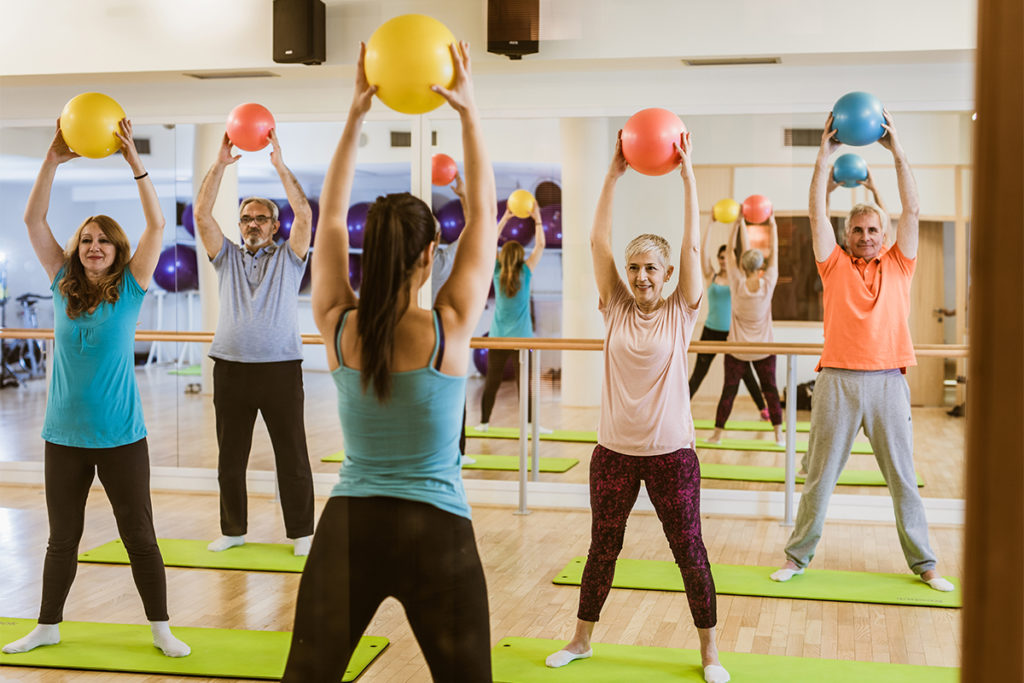Partner Exercises
Make partner training fun and interactive with these exercises designed for two.
In today’s society, people struggle to find enough time to complete work-related projects, enjoy their loved ones and also take good care of themselves. A personal fitness trainer (PFT) who can demonstrate to clients that they can spend quality time with their sweetie or friends while helping each other stay healthy and fit will be in high demand!
Partner training is more economical for clients than private sessions because the cost is split with another person. Partner training also increases your earning potential as a PFT. One way to price partner training sessions is to multiply your normal rate by 1.5 and divide by 2. For example, if your normal training session rate is $60 per hour, partner training would be $90. Each person would pay only $45.
The following partner exercises use a variety of equipment and will get a pair of clients interacting, having fun together and accomplishing a fabulous workout. These exercises can be done with anyone—spouses, best friends, co-workers or relatives. You also can do a few of these exercises with any of your one-on-one clients. Clients like it when trainers get involved in the session—it makes the workouts more fun and dynamic.
These exercises are also useful if you teach group training workouts and have a limited equipment budget. Because many of the exercises are done in pairs, you need just half the equipment you would normally require. Not only that, but partner exercises are great for developing teamwork and friendships in a group class!
Tubing Partner Exercises
Try these fun, effective partner exercises to build strength.

Mid-Row. Stand facing your partner. Intertwine the tubes, holding one handle each in your right and left hands. Back away from each other, arms fully extended, until there is some resistance on the tube. Begin in a squat stance with feet between hip and shoulder width apart. Slowly pull the tube, leading with your elbows, driving them backward. As you’re rowing backward, pinch your shoulder blades together and toward the ground. As you release your arms forward, squat toward the ground. Complete 1 set of 8–20 reps. This partner exercise helps improve posture.
Variations:
- Hold a static squat.
- Do single-arm rows. (Double up the tube in each arm.)
- Add rotation as you row.
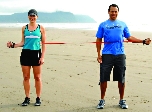
External Rotation. Stand side-by-side with your partner, facing the same direction. Each of you holds one handle of one tube in your outside arm. Your outside elbow, bent at 90 degrees, is anchored at your waist. Keeping your upper arm at your side, slowly rotate your forearm away from your body. Complete 1 set of 8–20 reps for each arm. This partner exercise strengthens weak rotator cuff muscles.
Variations: Try this exercise standing on one leg

Trunk Rotation. Stand facing your partner. Wrap the tubes around each other and each hold one handle in your right and left hands. Back away from each other until there is some light resistance on the tube. Contract your abdominals inward and maintain good posture throughout the entire exercise. Begin by rotating your torso one way while your partner rotates in the other direction. Slowly return to the starting position. Perform 8–20 reps on each side.
Variations:
- Keep the lower body static.
- Rotate/pivot through the lower body.
- Add one-arm rotation, to engage more of your upper body.

Lunge and Full-Body Rotation. Start facing sideways to your partner, holding one end of one tube in your hands. Lunge your outside leg (leg farthest away from your partner) forward while simultaneously rotating to the outside of your body. Press up and backward and do 8–20 reps one side; then repeat on the other side. Be sure that, while lunging, your front knee stays over your front foot and you always push from the leg in front. Both people lunge simultaneously.
Variations:
- Step forward (entry-level variation).
- Perform a deep lunge (more advanced variation).

Triceps Kickbacks. Stand facing your partner. Wrap the tubes around each other and each hold one handle in your right and left hands. Slowly bend forward at the hip while maintaining perfect posture and a long spine. Position both of your elbows up high and keep them there throughout the entire exercise. Your elbows will act as a hinge as you and your partner slowly straighten your arms backward. Your elbows should not move out of position. Slowly return to the starting position. Complete 1 set of 8–20 reps.
Medicine Ball Partner Exercises
Add some fun and power to clients’ workouts with these medicine ball partner exercises.
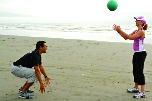
Partner Floor Slams. Start by standing upright and holding the medicine ball over your head. Keep your abdominals contracted throughout the entire exercise as you squat and throw the ball to the floor so that it bounces up toward your partner. Your partner catches the ball and quickly throws it back to you. Be sure you both maintain good posture. Continue for 60–120 seconds.
Variations: Try throwing the ball in different directions so your partner moves around to catch it (e.g., slam the ball side to side).
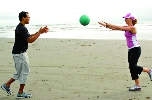
Single-Leg Partner Chest Pass. Stand facing your partner, each of you balancing on one leg. Keep your abdominals contracted and your body erect and stable. Pass the ball back and forth to each other using a basketball chest pass. Continue for 30–60 seconds on each leg.
Variations: Try hopping side to side, front and back, while passing.
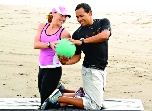
Kneeling Partner Twist. Kneel back-to-back with your partner. Keep your
abdominals contracted and maintain perfect posture. Slowly twist to one side and pass the ball off to your partner. Return to the other side to retrieve the ball. Continue for 30–90 seconds, going one way. Repeat, going the other direction.
Variations: Do this exercise while standing.
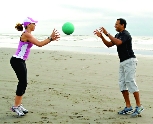
Partner Shuffle Drill. Stand facing your partner. Shuffle for about 10 feet, going one way, while simultaneously tossing the medicine ball back and forth to your partner. Repeat, going the opposite direction. Continue for 60–120 seconds.

Lunge and Chest Pass to Partner. Start by standing tall with perfect posture, facing your partner. Lunge forward as you throw the medicine ball to your partner using a chest pass. Your partner will catch the ball while performing a backward lunge. Repeat, lunging forward and backward. Remember to push off the front leg and be sure that your front knee stays over your front foot while lunging. Continue for 30–60 seconds each side.
Variations: Add a small step forward for deeper lunge progressions.

Partner Side Swing Pass. Stand side-by-side about 2 feet from your partner. Maintain perfect posture and keep your abdominals contracted throughout the entire exercise. Keep your arms straight and swing the ball from the outside of your body to the inside; then toss the ball to your partner. Your outside leg will pivot as you rotate across your body. Your partner catches the ball and repeats the exercise. Continue for 30–90 seconds each side.

Partner Sprint and Roll. Stand side-by-side with your partner. Start by rolling the ball forward on a diagonal so that it will intersect your partner’s path. You and your partner both sprint forward. Your partner catches up to the ball and rolls it forward and diagonally into your path. Continue sprinting and rolling for 60–120 seconds, going each way.

V-Sits With Rotation and Pass to Partner. Sit on the floor about 1–2 feet away from your partner with your knees bent. Sit upright with perfect posture, abdominals contracted tightly throughout the entire exercise. Start by holding the medicine ball into your chest. Now you and your partner recline back a few inches while maintaining perfect posture. Hold that position as you both rotate one way and then the other. Return to the starting position and, once you’re upright, throw the ball to your partner. Your partner will catch it, and you’ll both repeat the exercise. Repeat for 30–90 seconds.
Variations: Try facing the same direction and tossing the ball laterally to your partner.

Squat and Overhead Press Throw to Partner. Start by standing 5–6 feet away from your partner. Hold the medicine ball at chest level. Using an overhead press, toss the ball to your partner. Stay square to your partner. Your partner should catch the ball in an overhead position. Be sure to keep your abdominals contracted, your chest out and up, and your shoulders back and down. Continue for 30–90 seconds.
Variations: Try throwing the ball in different directions so your partner moves around to catch it (e.g., toss the ball side to side).
Develop balance and stability through partner exercises on the BOSU trainer.
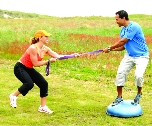
Survivor BOSU. Stand on the BOSU trainer. Your partner stands on the floor on one leg. Each of you holds one end of a rope. The only rule is that neither of you can let go of the rope. The goal of this game is for your partner to get you to touch one foot down to the ground. Of course, you are trying to make sure this doesn’t happen. Every time one of your feet touches down, your partner gets a point. Play the game for 2 minutes and then switch. This partner exercise is great for developing balance and stability.
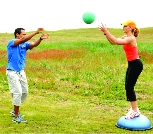
King of the BOSU. Stand on the BOSU trainer. Your partner stands on the floor holding a medicine ball. Again, his or her goal is to put you off balance so you touch down. The drill begins with your partner throwing the ball to you; you catch it and throw it back. Your partner can circle around you, leading you in one direction and then the other. You follow your partner by adjusting your feet and continuing to catch and throw the ball. Every time one of your feet touches down, your partner gets a point. Play the game for 2 minutes and then switch. This is another great drill for developing balance and stability.
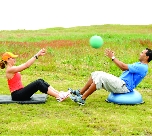
Six-Pack BOSU. Start by sitting on the BOSU trainer in a semireclined position. Be sure to keep your abdominals very tight throughout the entire drill. Your partner sits facing you. He or she throws the ball to you, and you catch it and throw it back. Your partner’s goal is to try to get you to lift one foot off the ground or to touch down with one of your hands. He or she can make the exercise more difficult by throwing the ball slightly off to one side, trying to put you off balance. Every time one of your feet lifts or your hand touches down, your partner gets a point. Play the game for 1.5 minutes and then switch. This is a great drill for developing abdominal strength and core stability.
If you don’t have access to equipment, you can still use these partner exercises with your clients:
Partner Squats. Start by facing your partner, holding onto each other’s arms. As you begin the exercise, each of you slowly squats backward, keeping your kneecaps pointing forward. Avoid allowing your knees to collapse inward. Try to keep your weight equally distributed on all four corners of your feet. Avoid allowing your arches to collapse inward. Lower until your upper thighs are parallel to the floor, or to a comfortable position. Now slowly extend back up. Complete 1 set of 8–20 reps. This exercise is good for developing trust in your partner!
Push-Up Contest. Nothing like a little contest to pump those muscles and have a little fun! But it’s important to level the playing field if one of you is clearly stronger than the other. So here’s how it goes: The stronger partner has to perform the push-ups on a slight decline or from a toe position. The less strong partner can be in an inclined position or do the push-ups from the knees. Make it is as fair as possible so that it’s actually a contest. Start together, go at the same tempo and see who can last the longest.
Oblique Crunches. Start by lying on your backs, facing opposite directions, with the outside of your hips almost touching. Keep your chin away from your chest, and focus your vision toward the ceiling at about 45 degrees. Avoid looking straight up at the ceiling or toward the opposite wall. Now slowly curl your torso up, rotate toward your partner and give him or her a “high five” with your farthest arm. Be sure to contract your abdominals on each repetition. Alternate sides, performing 8–15 reps on each side.
Sherri McMillan, MSc, and Alex McMillan, the 2006 IDEA Program Directors of the Year, own Northwest Personal Training & Fitness Education in Vancouver, Washington, and Portland, Oregon. Their studios were recently awarded the prestigious 2006 Better Business Bureau Business of the Year Award. They have been in the fitness industry for more than 18 years and have written numerous articles and presented hundreds of workshops internationally. Contact the authors at www.nwpersonaltraining.com.
Have a question about partner exercises? Ask it here.
Sherri McMillan, MS
Sherri McMillan, MSc, has been inspiring the world to adopt a fitness lifestyle for 30 years, and has received numerous industry awards, including the 2010 canfitpro International Fitness Presenter of the Year, 2006 IDEA Fitness Director of the Year, 1998 IDEA Personal Trainer of the Year and 1998 canfitpro Fitness Presenter of the Year. She is an international fitness presenter, personal trainer, fitness columnist for various magazines and newspapers, author of five books and manuals, including Go For Fit: The Winning Way to Fat Loss, Fit Over Forty, and The Successful Trainers Guide to Marketing, and a featured presenter in various fitness DVDs.





